材料科学与工程毕业论文
材料科学与工程专业毕业论文研究方向择优指南
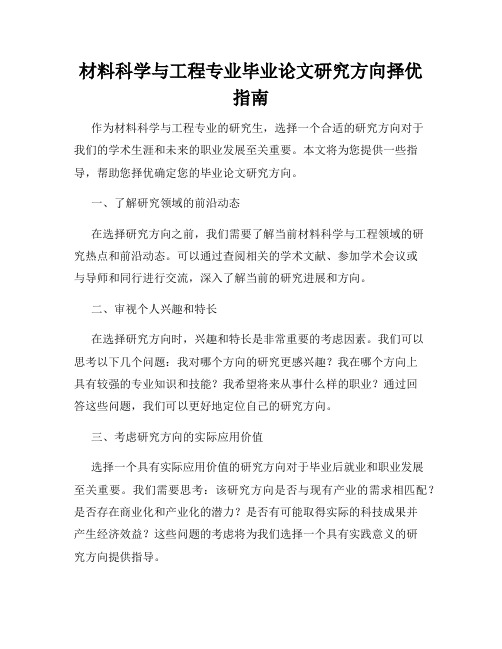
材料科学与工程专业毕业论文研究方向择优指南作为材料科学与工程专业的研究生,选择一个合适的研究方向对于我们的学术生涯和未来的职业发展至关重要。
本文将为您提供一些指导,帮助您择优确定您的毕业论文研究方向。
一、了解研究领域的前沿动态在选择研究方向之前,我们需要了解当前材料科学与工程领域的研究热点和前沿动态。
可以通过查阅相关的学术文献、参加学术会议或与导师和同行进行交流,深入了解当前的研究进展和方向。
二、审视个人兴趣和特长在选择研究方向时,兴趣和特长是非常重要的考虑因素。
我们可以思考以下几个问题:我对哪个方向的研究更感兴趣?我在哪个方向上具有较强的专业知识和技能?我希望将来从事什么样的职业?通过回答这些问题,我们可以更好地定位自己的研究方向。
三、考虑研究方向的实际应用价值选择一个具有实际应用价值的研究方向对于毕业后就业和职业发展至关重要。
我们需要思考:该研究方向是否与现有产业的需求相匹配?是否存在商业化和产业化的潜力?是否有可能取得实际的科技成果并产生经济效益?这些问题的考虑将为我们选择一个具有实践意义的研究方向提供指导。
四、寻找导师的建议和指导作为研究生,我们的导师是我们的知音和指导者。
在选择研究方向时,我们应该与导师进行深入的讨论,听取他们的建议和意见。
导师可以根据我们的学术背景、个人兴趣和职业目标为我们提供一些建议,并帮助我们进行方向的定位。
五、考虑研究方向的可行性和资源条件在选择研究方向时,我们还需要考虑研究的可行性和所需资源条件。
我们需要思考:我们是否有足够的时间和资金来支持这个研究方向?我们是否具备所需的实验设备和实验条件?我们是否可以获得必要的合作和支持?只有考虑到这些实际因素,我们选择的研究方向才能够真正可行。
综上所述,选择一个合适的研究方向对于材料科学与工程专业的研究生而言至关重要。
通过了解研究领域的前沿动态、审视个人兴趣和特长、考虑研究方向的实际应用价值、寻找导师的建议和指导,以及考虑研究方向的可行性和资源条件,我们可以更好地择优确定自己的毕业论文研究方向,为我们的学术生涯和职业发展奠定坚实的基础。
材料科学与工程论文范文

材料科学与工程论文范文随着科技的不断进步和发展,材料科学与工程作为一门重要的学科逐渐受到了人们的关注。
在材料科学与工程领域,人们通过研究材料的结构、性能和应用,为社会经济的发展做出了重要贡献。
本文将以某新型材料的研究为例,介绍材料科学与工程论文的写作格式和内容安排。
引言:材料科学与工程是一门综合性的学科,它研究材料的性能、结构以及在各个领域中的应用。
在引言部分,我们对所研究的新型材料进行简要描述,并说明为何选择这个材料进行研究。
同时,我们也需要概括已有研究中所存在的问题,以及本文所要解决的问题和研究目的。
材料与方法:在这一部分,我们需要详细介绍所研究的材料的制备方法、测试和分析方法等。
对于制备方法,可以列举所使用的材料、实验条件和步骤等;对于测试和分析方法,可以介绍所使用的仪器设备、实验步骤以及数据处理方法。
结果与讨论:在结果与讨论部分,我们可以先列出实验结果的数据和图表,并对其进行解读。
然后,我们可以将实验结果与已有的文献进行对比分析,指出实验结果的优点和不足之处。
通过讨论,我们可以进一步分析实验结果的原因,并提出改进意见或者进一步研究的方向。
结论:在结论部分,我们需要对整个研究工作进行总结,并给出研究结果的意义和应用前景。
同时,我们也可以提出一些该研究的局限性和未来研究的方向。
参考文献:在论文的最后,我们需要列出所引用的文献列表,以便读者查阅和参考。
总结:材料科学与工程论文的写作格式主要包括引言、材料与方法、结果与讨论、结论和参考文献。
在写作过程中,我们应该注重内容的准确性和科学性,避免出现诸如拼写错误、语法错误等对阅读体验产生不良影响的问题。
同时,合理的分节和标题设置可以提高文章的整体结构,使读者更加容易理解和阅读。
本文以新型材料研究为例,展示了材料科学与工程论文的写作范文。
希望通过本文的介绍,读者能够更好地了解材料科学与工程论文的写作方法和要求,从而提高自己的写作水平。
材料科学与工程论文框架

材料科学与工程学院Ⅰ、毕业论文编写格式封面:见附件4摘要:本文采用sol-gel方法,以钛酸丁酯为前躯体,水为溶剂,硝酸为催化剂,在低温下制备了水体系的溶胶。
通过反复浸涂在载玻璃片上制备出了一定厚度的二氧化钛薄膜。
关键词:溶胶-凝胶二氧化钛薄膜浸涂。
Abstract:This paper uses the sol-gel method, with tetrabutyl titanate as the precursor, water as solvent, nitric acid as catalyst, were synthesized at low temperature water system sol. Through repeated dip on the carrier sheet glass was prepared with certain thickness of titanium dioxide thin film.Key words: Sol - gel titania thin film coating论文目录:1 前言:TiO2是一种半导体材料,具有良好的光催化性能.1972年Fujishima和Honda报道了TiO2作为催化剂分解制备氢气,引起了学术界的广泛注意.1977年Bard用二氧化钛作为光催化剂将水中的CN―氧化为OCN,从而引起科研工作者对二氧化钛光催化性能的探索,特别是在环境材料科学领域内二氧化钛光催化与超亲水性薄膜的制备及性能研究和过渡金属掺杂对纳米二氧化太薄膜的微观结构、光致特性、电化学性质及在酸碱条件下的稳定性等进行了研究2文献综述:溶液是指微小的固体颗粒悬浮分散在液相中,并且不停的进行布朗动动的体系。
根据粒子与溶剂间的相互作用的强弱,通常将溶胶分为亲液型和憎液型两类。
由于界面原子的自由能比内部原子高,溶胶是热力学不稳定体系。
若无其它条件限制,胶粒倾向于自发凝聚,达到低比表面状态。
材料工程与科学 论文

材料工程与科学论文——二氧化钛纳米薄膜材料经过八周的课程学习,我逐步了解到有关于材料的一些知识。
之前只是知道材料就是我们日常生活所接触到的东西,出此之外也没别的了。
在学习了材料工程与科学之后才发现自己的认识是多么的肤浅,特此我也从老师所要求的对一种材料进行分析。
下面我将会从二氧化钛纳米薄膜材料的原材料——二氧化钛的来源、化学结构、化学性质,二氧化钛纳米薄膜材料的制备、性质、应用来阐述二氧化钛纳米薄膜材料。
首先是二氧化钛纳米薄膜材料的原材料——二氧化钛的来源。
二氧化钛,化学式为TiO2,俗称钛白粉。
多用于光触媒、化妆品,能靠紫外线消毒及杀菌,现正广泛开发,将来有机会成为新工业。
二氧化钛可由金红石用酸分解提取,或由四氯化钛分解得到。
还可以用其他的矿石来提炼二氧化钛,比如板钛矿、锐钛矿等,得到八面体晶体结构的TiO2。
然后是二氧化钛的化学性质:二氧化钛的化学性质极为稳定,是一种偏酸性的两性氧化物。
常温下几乎不与其他元素和化合物反应,对氧、氨、氮、硫化氢、二氧化碳、二氧化硫都不起作用,不溶于水、脂肪,也不溶于稀酸及无机酸、碱,只溶于氢氟酸。
但在光作用下,钛白粉可发生连续的氧化还原反应,具有光化学活性。
这一种光化学活性,在紫外线照射下锐钛型钛白粉尤为明显,这一性质使钛白粉即使某些无机化合物的光敏氧化催化剂,又是某些有机化合物光敏还原催化剂。
接着便是二氧化钛纳米薄膜材料的制备,在众多薄膜制备方法中,溶胶凝胶法是最常用的制膜技术,具有纯度高、均匀性好、合成温度低、反应条件易于控制及可实现化学计量比等优点,特别是制备工艺简单,无需特殊贵重仪器,可在各种不同形状的基底,如平面、柱体、管状、球体等不规则的基底上沉膜,还可在不同耐温材料的基底上沉膜,如在聚合物、橡胶、塑料等不能用高温处理的基板上采用提拉、旋涂、喷涂或注入法等沉积均匀的TiO2薄膜,甚至还可在室温下制备光催化TiO2薄膜二氧化钛纳米薄膜材料主要性质有两点:光催化性,亲水亲油性。
材料科学与工程专业毕业论文,论文范文,毕业论文参考选题表
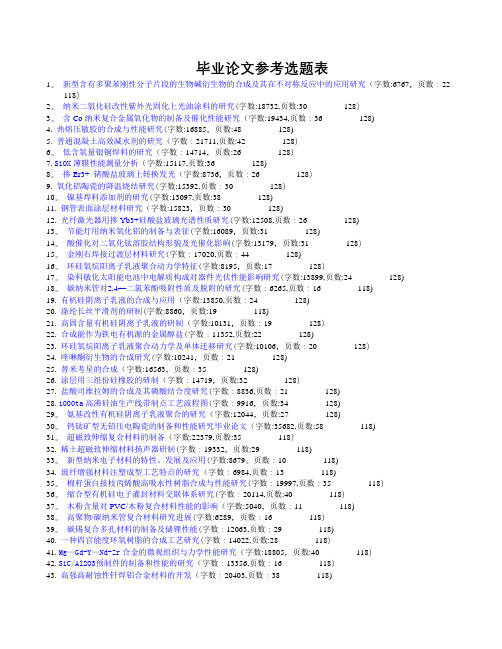
毕业论文参考选题表1。
新型含有多聚苯刚性分子片段的生物碱衍生物的合成及其在不对称反应中的应用研究(字数:6767,页数:22 118)2。
纳米二氧化硅改性紫外光固化上光油涂料的研究(字数:18732,页数:30 128)3。
含Co纳米复合金属氧化物的制备及催化性能研究(字数:19434,页数:36 128)4. 热熔压敏胶的合成与性能研究(字数:16885,页数:48 128)5. 普通混凝土高效减水剂的研究(字数:21711,页数:42 128)6。
低含氧量银铜焊料的研究(字数:14714,页数:26 128)7. SiOX薄膜性能测量分析(字数:15117,页数:36 128)8。
掺Er3+ 锗酸盐玻璃上转换发光(字数:8736,页数:26 128)9. 氧化铝陶瓷的降温烧结研究(字数:15392,页数:30 128)10。
镍基焊料添加剂的研究(字数:13097,页数:38 128)11. 钢管表面涂层材料研究(字数:15823,页数:30 128)12. 光纤激光器用掺Yb3+硅酸盐玻璃光谱性质研究(字数:12508,页数:26 128)13。
节能灯用纳米氧化铝的制备与表征(字数:16089,页数:31 128)14。
酸催化对二氧化钛溶胶结构形貌及光催化影响(字数:13179,页数:31 128)15。
金刚石焊接过渡层材料研究(字数:17020,页数:44 128)16。
环硅氧烷阳离子乳液聚合动力学特征(字数:8195,页数:17 128)17。
染料敏化太阳能电池中电解质构成对器件光伏性能影响研究(字数:13899,页数:24 128)18。
碳纳米管对2,4—二氯苯酚吸附性质及脱附的研究(字数:6265,页数:16 118)19. 有机硅阴离子乳液的合成与应用(字数:13850,页数:24 128)20. 涤纶长丝平滑剂的研制(字数:8860,页数:19 118)21. 高固含量有机硅阴离子乳液的研制(字数:10131,页数:19 128)22. 合成能作为铁电有机源的金属醇盐(字数:11352,页数:22 128)23. 环硅氧烷阳离子乳液聚合动力学及单体迁移研究(字数:10106,页数:20 128)24. 喹啉酮衍生物的合成研究(字数:10241,页数:21 128)25. 替米考星的合成(字数:16563,页数:35 128)26. 涂层用三组份硅橡胶的研制(字数:14719,页数:32 128)27. 盐酸司维拉姆的合成及其磷酸结合度研究(字数:8836,页数:21 128)28. 1000ta高沸硅油生产线带制点工艺流程图(字数:9916,页数:34 128)29。
材料科学与工程毕业论文文献综述
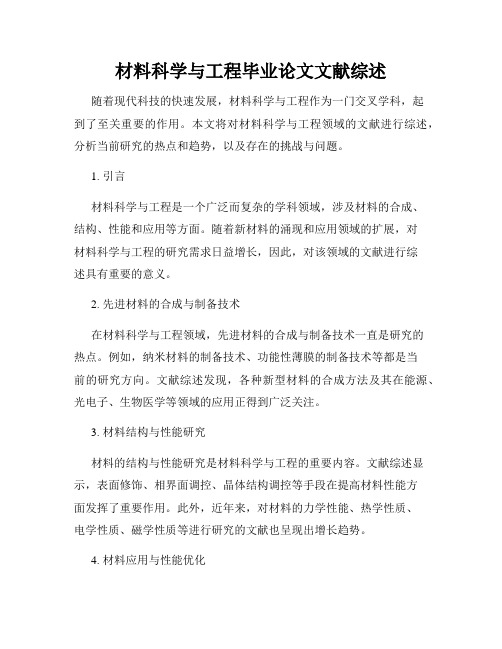
材料科学与工程毕业论文文献综述随着现代科技的快速发展,材料科学与工程作为一门交叉学科,起到了至关重要的作用。
本文将对材料科学与工程领域的文献进行综述,分析当前研究的热点和趋势,以及存在的挑战与问题。
1. 引言材料科学与工程是一个广泛而复杂的学科领域,涉及材料的合成、结构、性能和应用等方面。
随着新材料的涌现和应用领域的扩展,对材料科学与工程的研究需求日益增长,因此,对该领域的文献进行综述具有重要的意义。
2. 先进材料的合成与制备技术在材料科学与工程领域,先进材料的合成与制备技术一直是研究的热点。
例如,纳米材料的制备技术、功能性薄膜的制备技术等都是当前的研究方向。
文献综述发现,各种新型材料的合成方法及其在能源、光电子、生物医学等领域的应用正得到广泛关注。
3. 材料结构与性能研究材料的结构与性能研究是材料科学与工程的重要内容。
文献综述显示,表面修饰、相界面调控、晶体结构调控等手段在提高材料性能方面发挥了重要作用。
此外,近年来,对材料的力学性能、热学性质、电学性质、磁学性质等进行研究的文献也呈现出增长趋势。
4. 材料应用与性能优化材料应用与性能优化是材料科学与工程的重要研究方向。
文献综述显示,通过对材料的结构调控、表面修饰等手段,可以显著改善材料在光电子、电池、传感器、催化剂等领域的性能。
而在材料在极端环境下的应用中,如高温、高压环境下的材料应用,以及对材料的防腐蚀性能等方面的研究也备受关注。
5. 材料可持续性研究随着可持续发展理念的提出,对环境友好型材料及其制备技术的研究也成为材料科学与工程的重要课题。
文献综述发现,纳米材料、生物可降解材料、光催化材料等方面的研究在可持续性研究中占据重要地位。
6. 挑战与问题在材料科学与工程领域,仍然存在一些挑战和问题亟待解决。
例如,对材料性能与结构之间的关联性进行深入研究,对新材料在实际应用中的可行性进行评估等。
此外,材料的可持续性和环境友好性问题也需要持续关注和深入研究。
材料科学与工程论文
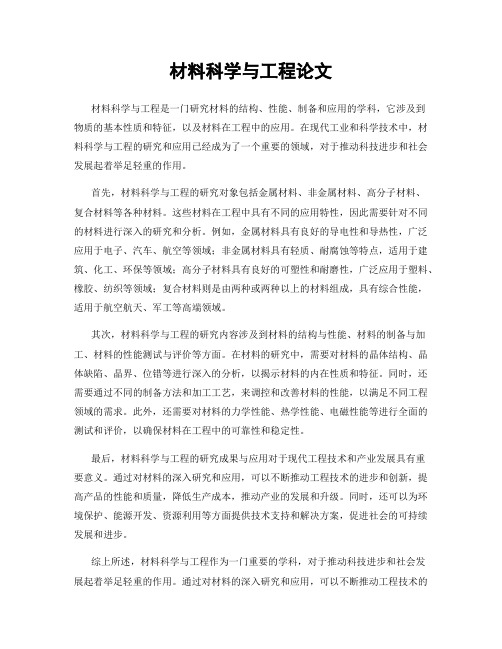
材料科学与工程论文材料科学与工程是一门研究材料的结构、性能、制备和应用的学科,它涉及到物质的基本性质和特征,以及材料在工程中的应用。
在现代工业和科学技术中,材料科学与工程的研究和应用已经成为了一个重要的领域,对于推动科技进步和社会发展起着举足轻重的作用。
首先,材料科学与工程的研究对象包括金属材料、非金属材料、高分子材料、复合材料等各种材料。
这些材料在工程中具有不同的应用特性,因此需要针对不同的材料进行深入的研究和分析。
例如,金属材料具有良好的导电性和导热性,广泛应用于电子、汽车、航空等领域;非金属材料具有轻质、耐腐蚀等特点,适用于建筑、化工、环保等领域;高分子材料具有良好的可塑性和耐磨性,广泛应用于塑料、橡胶、纺织等领域;复合材料则是由两种或两种以上的材料组成,具有综合性能,适用于航空航天、军工等高端领域。
其次,材料科学与工程的研究内容涉及到材料的结构与性能、材料的制备与加工、材料的性能测试与评价等方面。
在材料的研究中,需要对材料的晶体结构、晶体缺陷、晶界、位错等进行深入的分析,以揭示材料的内在性质和特征。
同时,还需要通过不同的制备方法和加工工艺,来调控和改善材料的性能,以满足不同工程领域的需求。
此外,还需要对材料的力学性能、热学性能、电磁性能等进行全面的测试和评价,以确保材料在工程中的可靠性和稳定性。
最后,材料科学与工程的研究成果与应用对于现代工程技术和产业发展具有重要意义。
通过对材料的深入研究和应用,可以不断推动工程技术的进步和创新,提高产品的性能和质量,降低生产成本,推动产业的发展和升级。
同时,还可以为环境保护、能源开发、资源利用等方面提供技术支持和解决方案,促进社会的可持续发展和进步。
综上所述,材料科学与工程作为一门重要的学科,对于推动科技进步和社会发展起着举足轻重的作用。
通过对材料的深入研究和应用,可以不断推动工程技术的进步和创新,为社会的可持续发展和进步做出贡献。
因此,我们应该加强对材料科学与工程的研究和应用,不断提高材料的性能和质量,推动科技创新,促进社会的发展和进步。
材料科学与工程毕业论文大纲

材料科学与工程毕业论文大纲第一部分:引言1.1 研究背景介绍材料科学与工程领域的重要性,以及当前对材料科学与工程的需求。
1.2 研究目的和意义说明本次毕业论文的研究目的和意义,以及对材料科学与工程领域的贡献。
1.3 研究内容和结构组织概述本次毕业论文的研究内容和结构组织,为后续章节做铺垫。
第二部分:文献综述2.1 材料科学与工程的发展历史回顾材料科学与工程的发展历程,重点介绍了材料科学与工程的里程碑事件和重要发现。
2.2 当前研究进展综述当前材料科学与工程的研究进展,包括新材料的发现、材料性能的改善等方面的研究成果。
第三部分:研究方法与实验设计3.1 研究方法选择说明本次研究采用的研究方法和原因,如理论分析、仿真模拟、实验研究等。
3.2 实验设计详细描述实验的设计方案,包括材料选择、实验条件、实验步骤等,确保实验的可重复性和科学性。
第四部分:研究结果与分析4.1 数据采集与处理介绍实验中采集到的数据及其处理方法,确保数据的准确性和可靠性。
4.2 研究结果呈现通过图表、数据分析等方式展示研究结果,分析实验数据的趋势和规律。
4.3 结果讨论与分析对研究结果进行讨论和分析,解释实验现象,探讨实验结果与预期目标之间的一致性或差异性。
第五部分:结论与展望5.1 结论总结总结本次研究的主要结论,指出本次研究的贡献和局限性。
5.2 存在问题与展望指出本次研究中存在的问题,并提出进一步研究的建议和展望,为后续研究提供指导和启示。
第六部分:参考文献列出本次毕业论文中所引用的文献,按照参考文献格式要求进行排版。
以上是《材料科学与工程毕业论文大纲》的初步阐述,具体内容可能会根据实际研究情况进行调整和补充。
本文档的目的是为了给您提供一个研究的框架和参考,帮助您顺利完成毕业论文的写作。
希望您能够根据自己的研究情况进行进一步的详细规划和展开,以取得理想的研究成果。
材料科学与工程导论课程论文
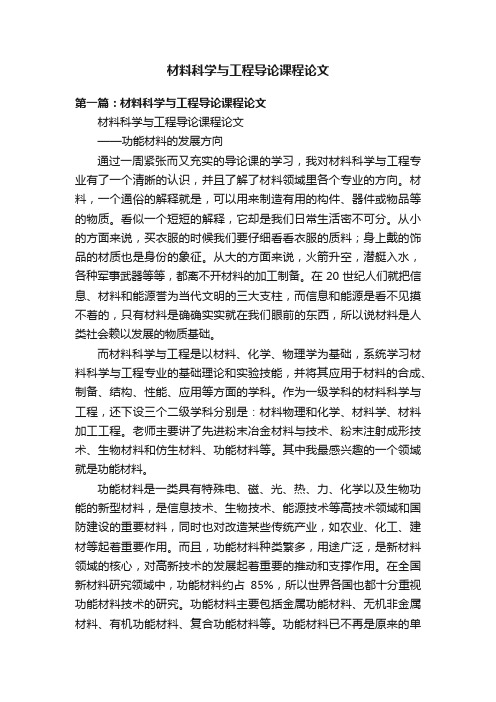
材料科学与工程导论课程论文第一篇:材料科学与工程导论课程论文材料科学与工程导论课程论文——功能材料的发展方向通过一周紧张而又充实的导论课的学习,我对材料科学与工程专业有了一个清晰的认识,并且了解了材料领域里各个专业的方向。
材料,一个通俗的解释就是,可以用来制造有用的构件、器件或物品等的物质。
看似一个短短的解释,它却是我们日常生活密不可分。
从小的方面来说,买衣服的时候我们要仔细看看衣服的质料;身上戴的饰品的材质也是身份的象征。
从大的方面来说,火箭升空,潜艇入水,各种军事武器等等,都离不开材料的加工制备。
在20世纪人们就把信息、材料和能源誉为当代文明的三大支柱,而信息和能源是看不见摸不着的,只有材料是确确实实就在我们眼前的东西,所以说材料是人类社会赖以发展的物质基础。
而材料科学与工程是以材料、化学、物理学为基础,系统学习材料科学与工程专业的基础理论和实验技能,并将其应用于材料的合成、制备、结构、性能、应用等方面的学科。
作为一级学科的材料科学与工程,还下设三个二级学科分别是:材料物理和化学、材料学、材料加工工程。
老师主要讲了先进粉末冶金材料与技术、粉末注射成形技术、生物材料和仿生材料、功能材料等。
其中我最感兴趣的一个领域就是功能材料。
功能材料是一类具有特殊电、磁、光、热、力、化学以及生物功能的新型材料,是信息技术、生物技术、能源技术等高技术领域和国防建设的重要材料,同时也对改造某些传统产业,如农业、化工、建材等起着重要作用。
而且,功能材料种类繁多,用途广泛,是新材料领域的核心,对高新技术的发展起着重要的推动和支撑作用。
在全国新材料研究领域中,功能材料约占85%,所以世界各国也都十分重视功能材料技术的研究。
功能材料主要包括金属功能材料、无机非金属材料、有机功能材料、复合功能材料等。
功能材料已不再是原来的单纯利用原材料,或者凭经验和技术改进和制造材料,或者设计材料的成分和性能,而是已经向设计新材料的阶段迈进。
天津理工大学材料科学与工程专业硕士毕业论文

天津理工大学材料科学与工程专业硕士毕业论文引言天津理工大学材料科学与工程专业是一个全面发展的学科领域,在现代工业和科学技术的发展中起着重要的作用。
本文旨在通过对天津理工大学材料科学与工程专业硕士毕业论文的研究,探讨该专业在培养学生科学素养、创新能力和实践能力方面的作用。
一、学生科学素养的培养天津理工大学材料科学与工程专业在硕士毕业论文中注重培养学生科学素养。
首先,通过课程选修的安排,学生在专业基础知识的学习过程中,掌握了系统的材料科学知识体系。
其次,学生在选择研究方向并进行研究的过程中,学会了科学思维和科学方法的运用。
最后,学生在撰写论文的过程中,通过查阅大量的文献资料,提高了信息检索和文献翻译的能力。
这些经历使学生具备了科学素养,为将来的科学研究和学术交流奠定了坚实的基础。
二、学生创新能力的培养天津理工大学材料科学与工程专业硕士毕业论文在培养学生创新能力方面起到了重要作用。
首先,学生在学习过程中,通过与导师的交流和指导,学会了进行独立思考和自主研究。
其次,对于某一特定的研究问题,学生需要整合已有的知识,提出创新的研究思路和方法。
最后,在论文撰写的过程中,学生需要通过自己的思考和总结,提出对研究问题的见解和结论。
这些经历锻炼了学生的创新能力,为将来从事科研工作打下了坚实的基础。
三、学生实践能力的培养天津理工大学材料科学与工程专业硕士毕业论文在培养学生实践能力方面也发挥着重要的作用。
首先,在研究选题的过程中,学生需要进行大量的实验和实践操作。
通过实践的过程,学生能够熟练掌握实验技术和实验设备的使用,提高了实验能力。
其次,在撰写论文的过程中,学生需要进行数据处理和结果分析,锻炼了数据分析和解决问题的能力。
最后,通过参与科研项目和学术交流,学生还能够拓宽学术视野,提高实践能力。
这些实践经历使学生能够将理论知识应用于实践中,并且能够独立进行科学研究。
结论天津理工大学材料科学与工程专业硕士毕业论文在培养学生科学素养、创新能力和实践能力方面起到了重要的作用。
材料科学与工程范文

材料科学与工程范文材料科学与工程是一门广泛应用于各行各业的学科,涉及到从基础研究到工业生产的各个方面。
材料科学与工程的目标是探讨材料的结构、性能和制备方法,并利用这些知识来开发新的材料,改进现有材料,并解决各种与材料相关的问题。
材料科学与工程主要关注的是材料的性质和性能。
这些性质包括机械性能、热性能、电性能、光学性能等。
材料的性能决定了它在不同应用领域中的适用性。
例如,汽车制造中需要使用强度高、刚度好、耐磨损的材料;电子行业中需要使用电性能好、导电性好的材料。
通过对材料的研究和理解,我们可以设计出具有特定性能的材料,以满足不同领域的需求。
材料的结构也是该学科的一个研究重点。
材料的结构决定了其性能。
例如,金属材料的结晶结构决定了其高强度和可塑性;纤维材料的结构决定了其高拉伸强度和超高模量。
通过研究材料的结构,我们可以改变材料的性能,并帮助我们理解和解决材料的各种问题。
材料的制备方法也是材料科学与工程的核心内容之一、材料的制备方法包括传统的熔融法、溶液法以及先进的沉积和制备技术,如化学气相沉积、物理气相沉积等。
这些制备方法可以控制材料的形貌、尺寸、组分和结构。
通过不同的制备方法,我们可以获得具有不同性质和应用的材料。
材料科学与工程的研究不仅仅局限于材料本身,还涉及到材料在实际应用中的性能和行为。
例如,我们可以研究材料在高温下的稳定性,以预测和防止材料在高温环境中的变形和失效。
我们也可以研究材料在腐蚀环境中的行为,以改善材料在腐蚀条件下的抗蚀性能。
通过对材料应用领域中的真实问题的研究,我们可以更好地理解和控制材料的性能,从而推动材料科学和工程的发展。
材料科学与工程的发展对于推动现代科技和工业的进步有着重要的意义。
材料是科技和工业的基础,各个领域都离不开材料的应用。
例如,先进制造业需要高性能的材料来提高产品质量和效率;生物医学需要生物相容性好的材料来制造人工骨骼和人工器官等。
通过改进材料的性能和开发新的材料,我们可以满足不同领域对材料的需求,推动科技和工业的进步。
材料科学与工程专业优秀毕业论文范本纳米材料的合成与应用研究

材料科学与工程专业优秀毕业论文范本纳米材料的合成与应用研究在材料科学与工程专业中,毕业论文是对学生在这个学科领域内的研究与实践成果的总结和展示。
本文将以纳米材料的合成与应用研究为主题,探讨材料科学与工程专业优秀毕业论文的范本。
一、引言纳米材料是一种在纳米尺度上具有特殊性能和结构的材料,具有广泛的应用前景。
近年来,纳米技术的快速发展为纳米材料的合成与应用提供了更多的可能性。
因此,研究和开发纳米材料已成为材料科学与工程专业的研究热点之一。
二、背景与意义纳米材料具有很多特殊的性质,包括特殊的力学性能、热学性能以及光学性能等。
这些特性使得纳米材料在电子器件、催化剂、生物医学和环境保护等领域具有广泛的应用前景。
因此,深入研究纳米材料的合成方法和应用性能,对于材料科学与工程专业的学生具有重要的意义。
三、纳米材料的合成方法1. 物理法:例如气相沉积、溅射法等。
2. 化学法:例如溶胶-凝胶法、溶液法等。
3. 机械法:例如球磨法、喷雾干燥法等。
四、纳米材料的应用研究1. 电子器件应用:纳米材料在半导体器件、集成电路和光电子器件中的应用研究。
2. 催化剂应用:纳米材料在催化剂领域的应用研究,如催化剂的制备与性能测试。
3. 生物医学应用:纳米材料在药物传递、生物成像和诊断等方面的应用研究。
4. 环境保护应用:纳米材料在清洁能源、污染物检测和废水处理中的应用研究。
五、纳米材料研究的挑战与展望1. 纳米材料的合成方法:尽管已经有多种纳米材料的合成方法,但仍需不断探索新的方法和改进现有的方法。
2. 纳米材料的性能优化:进一步研究纳米材料的性能,寻找提升其性能的方法和策略。
3. 纳米材料的应用拓展:将纳米材料应用于更广泛的领域,发掘其更多的潜力。
六、结论本文以纳米材料的合成与应用研究为主题,探讨了材料科学与工程专业优秀毕业论文的范本。
通过对背景和意义的介绍,以及对合成方法和应用研究的论述,可以帮助学生更好地理解纳米材料领域的研究动态和前沿技术。
材料科学与工程导论论文

材料科学与工程论文材料科学与工程是研究有关金属、无机非金属、有机高分子等材料的组成/结构、测试/表征、制备/合成、性能/应用四要素及其关系的科学技术与应用。
材料是人类用于制造物品、器件、构件、机器或其他产品的那些物质。
材料是物质,但不是所有物质都可以称为材料。
如燃料和化学原料、工业化学品、食物和药物,一般都不算是材料。
但是这个定义并不那么严格,如炸药、固体火箭推进剂,一般称之为“含能材料”,因为它属于火炮或火箭的组成部分。
材料是人类赖以生存和发展的物质基础。
20世纪70年代人们把信息、材料和能源誉为当代文明的三大支柱。
80年代以高技术群为代表的新技术革命,又把新材料、信息技术和生物技术并列为新技术革命的重要标志。
这主要是因为材料与国民经济建设、国防建设和人民生活密切相关。
材料除了具有重要性和普遍性以外,还具有多样性。
由于多种多样,分类方法也就没有一个统一标准。
从物理化学属性来分,可分为金属材料、无机非金属材料、有机高分子材料和不同类型材料所组成的复合材料。
从用途来分,又分为电子材料、航空航天材料、核材料、建筑材料、能源材料、生物材料等。
更常见的两种分类方法则是结构材料与功能材料;传统材料与新型材料。
结构材料是以力学性能为基础,以制造受力构件所用材料,当然,结构材料对物理或化学性能也有一定要求,如光泽、热导率、抗辐照、抗腐蚀、抗氧化等。
功能材料则主要是利用物质的独特物理、化学性质或生物功能等而形成的一类材料。
一种材料往往既是结构材料又是功能材料,如铁、铜、铝等。
传统材料是指那些已经成熟且在工业中已批量生产并大量应用的材料,如钢铁、水泥、塑料等。
这类材料由于其量大、产值高、涉及面广泛,又是很多支柱产业的基础,所以又称为基础材料。
新型材料(先进材料)是指那些正在发展,且具有优异性能和应用前景的一类材料。
新型材料与传统材料之间并没有明显的界限,传统材料通过采用新技术,提高技术含量,提高性能,大幅度增加附加值而成为新型材料;新材料在经过长期生产与应用之后也就成为传统材料。
材料科学与工程专业大学生毕业论文范文评析

材料科学与工程专业大学生毕业论文范文评析材料科学与工程专业的大学生毕业论文是研究生涯的重要成果之一。
通过撰写毕业论文,学生能够总结在这个专业领域的所学知识,并展示他们的研究能力和创新思维。
然而,随着论文数量的增加,质量的提升成为毕业论文撰写过程中的一个重要课题。
因此,本文将对一篇材料科学与工程专业大学生毕业论文进行范文评析,分析其优点和不足之处,并提供改进建议。
这篇范文选取的题目是“钢铁材料中碳化物的析出行为及其对力学性能的影响”。
作者在文章中通过对钢铁材料中碳化物析出行为进行研究,探讨了这些析出行为对钢铁的力学性能的影响。
本文的结构分为引言、文献综述、实验方法、结果与讨论以及结论等几个部分,下面将对这五个部分进行评析。
在引言部分,作者能够明确地说明本研究的背景和意义。
他指出了钢铁材料中碳化物析出行为对力学性能的重要性,并提出了研究该问题的目的和方法。
这样的引言能够让读者对本文的研究内容有一个初步的了解,并引发兴趣。
接下来是文献综述部分,在这一部分,作者对相关领域的研究进行了全面而系统的回顾。
作者列举了大量的文献,对碳化物的形成机制、成分、性能和应用做了详细的讨论。
这样的文献综述有利于读者对该领域的知识进行了解,并能更好地理解作者后续的实验和讨论。
接着是实验方法部分,作者详细地描述了实验的过程和步骤,并给出了相关的实验条件和参数。
作者还对实验中可能的误差进行了分析,并提出了相应的改进措施。
这样的详细方法描述有助于读者了解作者的实验设计和可行性。
结果与讨论部分是该论文的核心部分。
在这一部分,作者将实验结果进行了详细的统计和分析,并将其与前人的研究结果进行了对比。
作者还对结果进行了深入的讨论,并提出了自己的见解和观点。
这种系统而细致的结果与讨论部分能够使读者对该研究有更全面的认识,并有助于其他研究者的进一步研究。
最后是结论部分,作者对整篇研究进行了总结,并提出了对未来研究的展望。
作者能够简明扼要地总结他的研究结果,并提出了对该领域的进一步研究方向。
材料科学与工程专业毕业论文选题参考新型功能材料的合成与性能研究

材料科学与工程专业毕业论文选题参考新型功能材料的合成与性能研究材料科学与工程专业毕业论文选题参考:新型功能材料的合成与性能研究摘要:本文旨在探讨新型功能材料的合成与性能研究。
首先介绍了新型功能材料的概念和意义,随后阐述了合成方法的选择与优化,再通过多种分析技术对材料的性能进行评估与研究。
最后总结了这些研究对新型功能材料的应用前景和发展趋势的推动作用。
1. 引言材料科学与工程是一门研究材料的合成、性能与应用的学科,新型功能材料正是材料科学与工程领域的研究热点之一。
新型功能材料具有多种优越性能,如高强度、高导电性、高热稳定性等,广泛应用于能源、环境科学、生物医学等领域。
因此,对新型功能材料的合成与性能研究具有重要的意义。
2. 合成方法选择与优化合成方法是制备新型功能材料的重要环节。
根据所需材料的结构与性能,在一系列已有的合成方法中选择适合的方法进行研究。
例如,溶胶-凝胶法、水热法、溶剂热法等都是常用的合成方法,可以根据材料的特性选择最佳的合成途径。
同时,在合成过程中优化实验条件,如温度、pH值、反应时间等,以获得理想的材料性能。
3. 性能评估与研究对新型功能材料的性能评估与研究是确保其应用价值的关键。
本节将介绍几种常用的性能评估方法。
3.1 结构表征结构表征可以通过扫描电子显微镜(SEM)、透射电子显微镜(TEM)和X射线衍射(XRD)等技术对材料的结构与形貌进行观察和分析。
3.2 物化性质测试物化性质测试是对材料的物理性质、化学性质以及热学性质等进行分析。
例如,利用傅里叶红外光谱(FTIR)测试材料的功能基团,采用紫外-可见分光光度计(UV-Vis)测试材料的吸收与发射特性等。
3.3 功能性能测定对于功能材料,其特殊的功能性能是评价其优劣的重要标准。
例如,如果研究的目标是新型光催化材料,可以通过光催化降解染料来测试其光催化性能;如果研究的目标是新型电池材料,可以测定其电化学性能,如循环伏安法(CV)和电化学交流阻抗谱(EIS)等。
“材料科学与工程”专业毕业设计(论文)教学改革的探索与实践
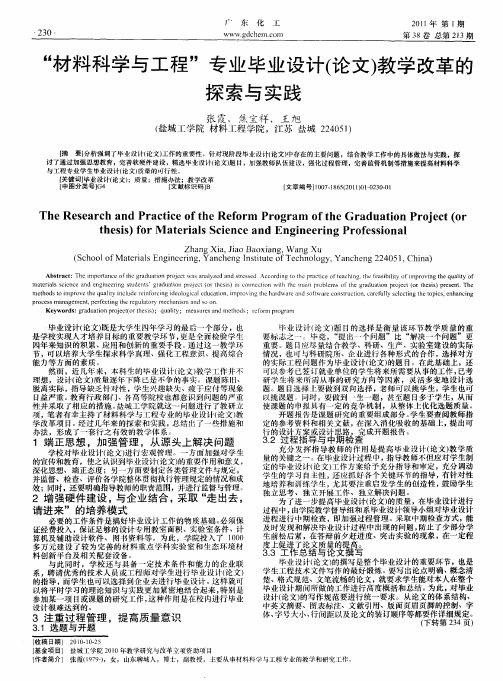
Th sa c n r cieo eReo m r g a o eGr d ainP o t o eRee rha dP a t f h fr P o r m f h a u t rjc (r c t t o e t ei frMaeil S in e n gn eigP oes n l h s ) o tras ce c dEn iern r fsi a s a o
Zh n i Ja o a g. a a g X a io Ba xin W ng Xu
( c o l f tras n ie rn , n h n n tu eo Te h oo y Ya c e g2 4 5 Chn ) S h o Maeil gn eig Ya c e gI si t f c n lg , n h n 2 0 1 o E t i a
Ke wo d : rd a o rjc o ei ;q ai y r s ga u t n o t r h s ) u l i p e( t s t y;me srs n to s e r rga aue d h d ;rf m po r a me o m
毕业设计( 论文) 既是大学生 四年学 习的最后一个部分,也 是 学校实现人才培养 目标 的重要教学环节 , 更是全面检验 学生 四年来 知识 的积累、应用和创新的重要手段 。 通过这一教 学环 节 , 以培养大学生探求科学真理、强化工程意识、提高综合 可 能 力等 方面 的素 质 。 然而 ,近几年来 ,本科 生的毕业设计( 论文) 教学工作 并不 理想 ,设计( 文) 论 质量逐年下降 已是不争 的事实 。课题陈 旧、 脱离实 际,指导缺乏针对性 ,学生兴趣缺 失、疲于应付等现象 日益 严 重 。 育 行 政 部 门、各 高 等 院校 也 都 意识 到 问题 的严 重 教 性 并采 取 了相 应 的措 施 。 城 工 学 院 就 这 … 问 题 进 行 了教 研立 盐 项 , 者 有 幸 主 持 了材 料 科 学 与 工 程 专 业 的 毕 业 设计( 文 ) 笔 论 教 学改革项 目。 经过几年来 的探索和实践 , 总结出了一些措施和 办法 ,形 成 了一 套 行 之 有 效 的教 学 体 系 。
材料科学与工程专业 毕业论文

毕业论文超高温材料硼化锆粉体的制备学院:专业:学生姓名:学号:指导教师:2012年06月中文摘要论文采用在真空中利用碳还原法进行硼化锆粉体的制备,该方法是以氧化锆、活性炭、碳化硼和氧化硼为主要原料,研制出纯度较高,颗粒较小且制作工艺简单、成本较低的硼化锆粉体。
本文主要研究在碳热还原反应中,碳含量、烧成温度和保温时间对反应产物的影响。
通过对反应产物进行XRD、SEM等测试分析,找到一条制取高质量硼化锆粉体的反应路线:(1)碳含量要过量;(2)烧成温度为1650℃保温时间为1.5小时。
关键词:碳热还原法硼化锆碳含量反应温度保温时间AbstractThe ZrB2 powers are prepared in vacuum by carbothermal reduction method with ZrO2 powers ,B2O3powers, B4C powers ,and activated carbon as the main raw material. Lower cost of ZrB2powers have been developed which have high purity, smaller particles and simple production technology. This paper mainly studies effect of the content of carbon content, sintering temperature and holding time on the influence of reaction products in carbothermal reduction method. Through testing and analyzing the SEM, XRD of the ZrB2 powers, the results show that high quality ZrB2 powders can be synthesized with the optimum processing parameters as follows: (i) Activated carbon should be excessive; (ii) the condition of carbothermal reduction heat treatment is at 1650°C for 1.5h.Key words:carbothermal reduction method, ZrB2 powers,carbon content, reaction temperature,the time of heat目录中文摘要 (1)ABSTRACT(英文摘要) (I)第一章:引言 (1)1.1课题的目的和意义: (1)1.2近几年来国内外研制状况 (2)1.2.1硼化锆陶瓷应用举例 (2)1.2.2近几年Z R B2粉体研究方向 (3)1.2.3利用碳热还原法制备Z R B2粉体研究状况 (4)1.3超高温材料硼化锆粉体的制备及影响因素 (5)1.3.1超高温材料硼化锆粉体的制备 (6)1.3.2制备硼化锆粉体的影响因素 (7)1.4本课题的研究对象、内容和目标 (7)第二章试验方法 (9)2.1试剂和仪器: (9)2.1.1主要试剂: (9)2.2碳还原法概述: (9)2.2.1碳还原法制备鹏化工粉体的原理和特点: (10)2.2.2碳还原法制备硼化锆粉体的主要步骤: (11)2.2.3技术路线: (12)2.2.4注意事项: (12)2.3试样的制备: (12)2.4烧成制度: (13)第三章结果与讨论 (14)3.1XRD衍射图谱分析(物相分析) (14)3.1.1碳的添加量对硼化锆粉体的影响 (14)3.1.2保温时间对硼化锆粉体的影响 (16)3.1.3反应温度对硼化锆粉体的影响 (18)3.2Z R B2粉体显微结构分析 (20)第四章结论 (23)参考文献 (24)致谢................................................................................................................ 错误!未定义书签。
- 1、下载文档前请自行甄别文档内容的完整性,平台不提供额外的编辑、内容补充、找答案等附加服务。
- 2、"仅部分预览"的文档,不可在线预览部分如存在完整性等问题,可反馈申请退款(可完整预览的文档不适用该条件!)。
- 3、如文档侵犯您的权益,请联系客服反馈,我们会尽快为您处理(人工客服工作时间:9:00-18:30)。
材料科学与工程毕业论文材料科学与工程毕业论文专业:材料科学与工程掺杂Tb3+的ZnO-Ga2O3-SiO2玻璃陶瓷的制备及其发光性能摘要本文简述了发光材料相关理论:简述发光材料的发光过程和发光机理,介绍了稀土离子的光谱理论,概括了稀土发光材料的常用制备方法的进展和面临的问题。
采用溶胶-凝胶法制备掺杂Tb3+的ZnO-Ga2O3-SiO2(ZGS)玻璃陶瓷和共掺杂Tb3+,Eu3+的ZGS玻璃陶瓷发光材料,利用热分析(DTA-TG)、X射线衍射(XRD)和荧光光谱(PL)等测试手段,分析各组成含量对其中的纳米晶体组成和对料的发光性能的影响,通过不同工艺参数和组成对比,获得最佳的制备工艺和组成含量。
对掺杂Tb3+的ZGS玻璃陶瓷的相组成和发光性能进行了检测。
XRD结果表明:从700℃开始有纳米晶体形成,900℃烧结为最佳。
当组成中n(Zn)/n(Ga)=0.58时样品获得只有ZnGa2O4晶体分布在无定型SiO2玻璃基体的玻璃陶瓷。
Tb3+位于ZnGa2O4晶体与玻璃相的交界处。
激发光谱分析表明,掺杂Tb3+的ZGS玻璃陶瓷为Tb3+特征激发,最强激发峰为255nm,是Tb3+的4f-5d跃迁,次强激发峰为377nm,是Tb3+的4f-4f跃迁。
发射光谱分析表明Tb3+的ZGS玻璃陶瓷呈现Tb3+的特征绿光发射,为Tb3+的5D4→7F J (J=6,5,4,3)跃迁发射,最强发射峰位于545nm,属于Tb3+的5D4→7F5磁偶级跃迁。
掺杂Tb3+,Eu3+的ZGS玻璃陶瓷只表现出Eu3+的发光性能,为Eu3+的D0→7F J (J=0,1,2,3,4)特征跃迁,最强发射峰为615nm,是红光发射,为5D0→7F2电偶极跃迁。
可能的原因是少量的Tb3+没有掺入晶体中。
关键词:溶胶-凝胶法,Tb3+掺杂,镓酸锌,玻璃陶瓷,发光性能材料科学与工程毕业论文Reparation and Photoluminescence Properties of Tb3+-doped ZnO-Ga2O3-SiO2 glass-ceramicsAbstractThe thesis describes the related theories of luminescent materials: introduces the spectral theory of the rare-earth ions, summarizes the luminescent progress and luminescence mechanism of rare-earth luminescent materials and progress and faced problems of commonly used preparation methods of the luminescent materials. Tb3+-doped ZGS glass-ceramics and Tb3+,Eu3+-co-doped ZGS glass- ceramics of luminescent materials were preparation by sol-gel method. Using thermal treatment (DTA-TG), X-ray diffraction (XRD) and fluorescence spectra (PL) test methods, analysis of effect on the nanocrystals composition and luminescent properties by the content of each composition. Contrast to different process parameters and composition of the content to get the best preparation process and composition of the content.The composition and luminescent properties of Tb3+-doped ZGS glass-ceramics were tested. XRD results showed that the formation of nanocrystals from 700 ° C and 900℃ is the best sintering temperature. The sample only ZnGa2O4crystals distributed in the amorphous SiO2 glass matrix when the composition of n (Zn) / n (Ga) = 0.58. The Tb3+ localized at the interface between the ZnGa2O4crystal particles and the glassy phase.Excitation spectrum analysis showed that Tb3+-doped ZGS glass-ceramics are the characteristic excitation of Tb3+. The strongest excitation peak is at 255nm, which is the 4f-5d transition of Tb3+, and the second stronger excitation peak is at 377nm, which is the 4f-4f transition of Tb3+. Emission spectral analysis showed that of Tb3+-doped ZGS glass-ceramics present features green emission of Tb3+,which is the 5D4→7F J (J=6,5,4,3) transition emission. The strongest emission peak is at 545nm, belonging to the 5 D4→7F5 magnetic dipole transition of Tb3+.Tb3+,Eu3+-co-doped ZGS glass-ceramics only show the luminescence properties of Eu3+, which is the D0→7F J(J=0,1,2,3,4)characteristic transitions of Eu3+. The strongest emission peak is at 615nm, which is red emission belonging to the 5D0→7F2 electric dipole transitions of Eu3+. The likely reason is that a small amount of the Tb3+not doped crystals.Keyword: sol-gel, Tb3+doping, ZnGa2O4, glass-ceramics, luminescent properties材料科学与工程毕业论文目录摘要 (II)Abstract ...................................................................................................................................... I II 第一章绪论 (1)1.1 引言 (1)1.2 发光过程 (2)1.3 发光机理 (2)1.3.1 发光的能带理论 (3)1.3.2 位型坐标模型 (5)1.4 稀土离子的光谱理论 (6)1.4.1 能级结构 (6)1.4.2 +3价态的稀土离子的光谱特性 (7)1.4.3 非正常价态稀土离子的光谱特性 (8)1.5 稀土发光材料的制备方法 (9)1.5.1 高温固相反应法 (9)1.5.2 燃烧合成法 (9)1.5.3 微波加热法 (10)1.5.4 水热/溶剂热法 (10)1.5.5 喷雾热解法 (10)1.5.6 化学沉淀法 (11)1.5.7 溶胶-凝胶法 (11)1.6 本课题研究的来源与意义 (12)1.7 本课题研究的内容 (13)第二章实验方法 (14)2.1 实验原料与设备 (14)2.2 样品的制备 (14)2.3 性能表征 (16)第三章实验结果与讨论 (17)3.1 DTA-TG热分析 (17)3.2 X射线衍射分析 (19)3.3 光谱分析 (22)第四章结论 (28)致谢 (29)参考文献 (30)毕业论文第一章绪论1.1 引言发光材料又称发光体,是一种能够把从外界吸收的各种形式的能量转换为非平衡光辐射的功能材料[1,2]。
光辐射有平衡辐射和非平衡辐射两大类,即热辐射和发光。
任何物体只要其有一定的温度,则该物体必定具有与此温度下处于热平衡状态的辐射(红光、红外辐射)。
非平衡辐射是指在某种外界作用的激发下,体系偏离原来的平衡态,如果物体在回复到平衡态的过程中,其多余的能量以光辐射的形式释放出来,则称为发光。
因此发光是一种叠加在热辐射背景上的非平衡辐射,其持续时间要超过光的振动周期。
当外界激发源对材料的作用停止后,发光还会持续一段时间,称为余辉。
这是固体发光与其他光发射现象的根本区别。
一般以持续时间10-8s为分界,短于10-8s的称为荧光,长于10-8s的称为磷光。
发光材料的发光方式是多种多样的,主要类型有:光致发光、阴极射线发光、电致发光、热释发光、光释发光、辐射发光等[3]。
不同材料在不同激发方式下的发光过程可能不同。
但它们的共同之处是其中的电子从激发态辐射跃迁到基态或其他较低能态使离子、分子或品体释放出能量而发光。
发光物质已成为人们日常生活中不可缺少的材料,广泛地应用于照明设备、彩色电视荧光屏和大屏幕彩色显示板、电脑显示器、X射线增感屏、X射线断层扫描医疗诊断技术和荧光免疫检测分析等者多方面。
此外,发光材料也用于冶金(金属材料或容器的γ射线探伤无损检测系统中的荧光屏或闪烁体)、农业(捕杀棉铃虫的黑光灯)、医疗卫生(健康射线灯,用作放射疗法检测系统的闪烁体)、国防(示波器和雷达显示屏,用于红外线夜视的上转换材料)、市容建设(具有夜明效果的长余辉材料和电致发光材料)、核能物理(核辐射探测系统的闪烁体)和高能物理(高能粒子检测系统的闪烁体)等领域[4]。
